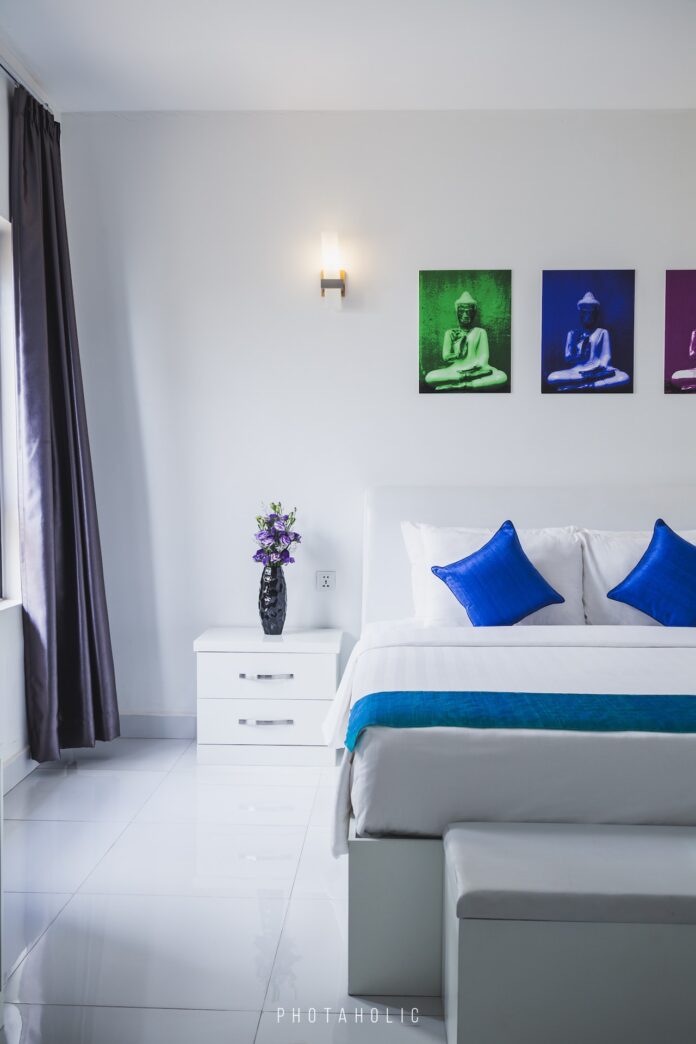The bedroom affects your ability to sleep well. When you feel calm and content, you’re more likely to fall asleep quickly. The colours in your bedroom, in particular, can make the difference between a good night’s sleep or a night spent tossing and turning.
Colour psychology experts found that some colours put us at ease, while others cause us to feel alert. Geoff McKinnen, certified sleep coach at Amerisleep, shares the best and worst colours for sleep, so you can better understand how colour affects the circadian rhythm.
Best Bedroom Colours for Sleep
The best colours for sleep are blue, yellow, green, silver, orange, and pink. These colours reduce stress and soothe the nervous system. Try to stick with neutral or pastel shades for a soft, welcoming atmosphere.
Blue
One of the best bedroom colours is blue because it’s associated with calm and relaxation. The brain is more perceptive to the colour blue than any other colour thanks to special receptors called ganglion cells, located in the retinas.
Ganglion cells collect information from visual surroundings and transform this information into chemical signals to the hypothalamus, a part of the brain responsible for producing hormones, like melatonin and cortisol. Melatonin is a sleep hormone and influences the sleep-wake cycle, and cortisol is a stress hormone, keeping your alert during the day.
Blue is a non-stimulating colour, so when you see blue, the hypothalamus produces more melatonin and less cortisol. In contrast, a red room stimulates the brain and produces more cortisol, resulting in poor sleep quality.
Yellow
Softer shades of yellow create a tranquil environment because the muted tone imitates sunshine. Soft yellows alleviate stress and promote tranquillity, so you can sleep peacefully. Brighter hues boost energy and should be avoided.
Green
The colour green is another excellent colour choice for relaxation. Green is also another easy colour for the eyes to see because, like the colour blue, they are sensitive to green light. Similar to a blue room, a green room helps us feel calm and peaceful because green is a non-stimulating colour. The best green colours for sleep should have blue tones—warm tones like yellow may cause you to feel energetic instead of helping you unwind.
Silver
Silver is a great choice if you prefer neutral colours. Unlike dark grey tones, silver induces calm. Be sure to choose a matte silver colour and not a shiny paint—the shine reflects any bright light, keeping you awake.
Orange
Light orange colours, including tan and beige, have a warm tone reminiscent of a sandy beach, creating a welcoming space in your bedroom. Choose orange colours with brown undertones, like terracotta, and avoid bright orange colours because they are invigorating to the brain.
Pink
Pink may not seem like a good colour for the bedroom because of its red tones, but a soft, natural pink gives off a tranquil feeling. Avoid bright red tones.
Worst Bedroom Colours for Sleep
Purple, Grey, brown, and red are the worst colours for sleep. Grey and brown promotes negative emotions, while purple and red boost alertness. Individuals with these bedroom colours are more likely to sleep less than 7 hours each night.
Bright Purple
Bright purple is not a good choice for the bedroom. Bright purple hues have reddish undertones, increasing energy levels and keeping you alert, but softer purple shades may boost sleepiness. If you’re set on painting your bedroom purple, try to choose a more muted tone, like lavender, because of its cool undertones.
Dark Grey
Dark grey promotes depression because it gives a similar feel like a rainy day. Dark grey is a good accent colour but painting the walls this dark shade and adding grey bedding creates a sombre atmosphere. Silver or grey with blue undertones are better choices if you want a neutral colour.
Brown
Brown is a gloomy colour, increasing subconscious feelings of sadness and causing restlessness instead of sleep—not exactly a cosy feel for the bedroom atmosphere.
Red
Red is an invigorating colour, increasing heart rate. One study found the colour red increases brain activity and boosts alertness, something you don’t want when trying to relax and fall asleep.
Painting Tips
Before painting the bedroom walls, we recommend using flat paint and establishing a colour scheme with sleep-promoting colours to create a cosy environment conducive to sleep.
Flat Paint
Stick with flat paint, instead of one with a high-shine or glossy finish. The shine reflects light, disrupting sleep. Flatter paints absorb light and are less invigorating, promoting relaxation.
Colour Scheme
Decide on a colour scheme for your bedroom before painting to avoid colour clashing. Choose colours parallel to each other on the colour wheel—contrasting colours are stimulating, because they clash with each other, so instead of a sleep-inducing environment, you may feel anxious and restless.
FAQs
What colour light helps you sleep?
Warm light is better for sleep because the eyes are less sensitive to the longer wavelengths in warm light. Light bulbs with a yellow or red hue and are best for bedside lamps. Blue light, on the other hand, is the worst for sleep. Blue light from LED light bulbs and electronic devices disrupts melatonin production because your eyes are more sensitive to blue light.
Are white sheets a good colour for sleep?
White bedding is an excellent choice for sleep because the neutral tone doesn’t stimulate the brain, unlike bright red and purple tones. White is neutral and has a relaxing effect, pairing well with other colours conducive to sleep, including blues and yellows.
What colours make a room look bigger?
Soft shades and natural colours can make a room appear bigger and more open—you may want to consider light blues, pale greens, and off-white colours for smaller spaces, like a studio or one-bedroom apartments where space is limited. Another technique is painting the moulding a lighter colour than the walls, giving the illusion of a larger bedroom.
What are good neutral tones for the bedroom?
If you can’t sleep, don’t force yourself to stay in bed—this increases stress and makes it harder to fall asleep. Instead, get up, leave the room, and do a simple activity, like writing in your journal or reading a book. When you start to feel sleepy, go back to bed.
What colour helps with anxiety?
Researchers have found the colour blue induces feelings of tranquillity and peacefulness, the opposite of anxiety. A blue room doesn’t alert the mind, and instead, promotes calm, so you feel more at ease—you’re likely to fall asleep and stay asleep than you would if sleeping in a brightly-painted bedroom.
Conclusion
Some of the best colours for sleep have a soft, natural hue to create a calm atmosphere, perfect for deep sleep. Choose colours appealing to your taste and create a colour scheme to enhance sleep. Light blue is one of the best colours for sleep because the soft tone creates a calm and inviting atmosphere conducive for sleep.
The information was provided by Amerisleep, an award-winning producer of mattresses, beds, and sleep accessories.
Credit to amerisleep.com who carried out the survey
Help keep news FREE for our readers
Supporting your local community newspaper/online news outlet is crucial now more than ever. If you believe in independent journalism, then consider making a valuable contribution by making a one-time or monthly donation. We operate in rural areas where providing unbiased news can be challenging. Read More About Supporting The West Wales Chronicle























